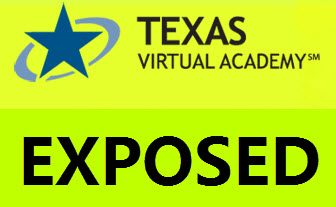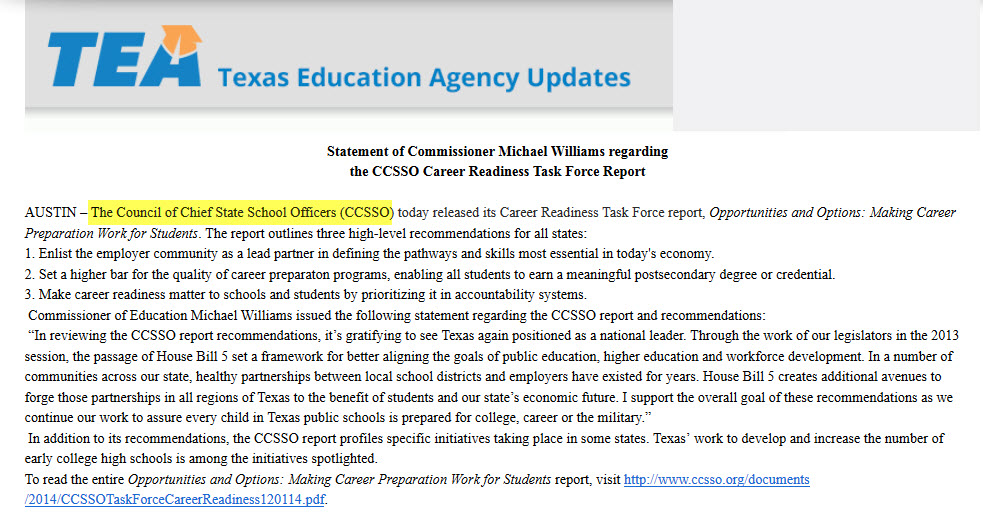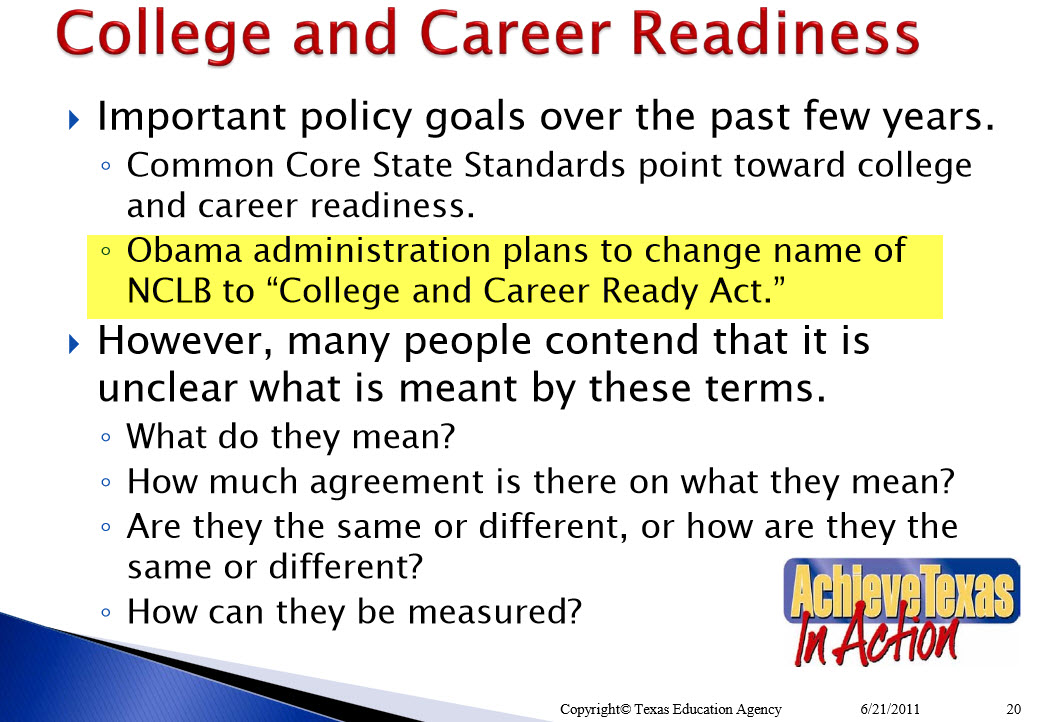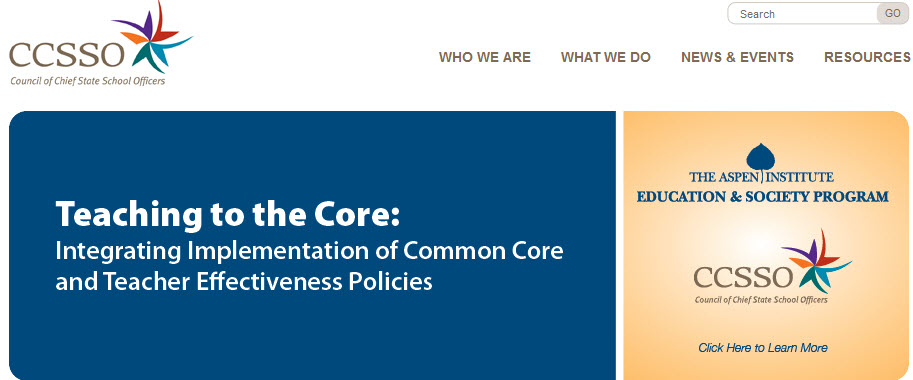http://www.educationviews.org/k12-texas-virtual-academy-exposed

http://www.educationviews.org/k12-texas-virtual-academy-exposed
[1.20.14 — Darcy Bedortha (high-school English teacher with a Ph.D) has recently been a teacher in K12, Inc. Her article is an expose´on what really happens in a K12, Inc. which is a virtual school. Students “attend” this school by e-mail, interactive/online instruction, and telephone contact with the teacher — no face-to-face time between the teacher and the student — EducationWeekis a well-respected publication and vets its contributors.
Unfortunately, Texas Virtual Academy uses K12, Inc. as its curriculum: http://www.k12.com/txva/curriculum/3-8#.Us62e9JDtac
This article written by Darcy Bedortha, a teacher in K12, Inc. and published in EdWeek, is a “must read” for anyone who is considering signing his children up for the Texas Virtual Academy/K12, Inc. Darcy’s article should also be a “must read” for the Texas Legislature, Governor’s office, Lt. Governor’s office, Texas Commissioner of Education, and the Texas Education Agency.
I remember when the political forces jammed through the Texas Virtual Academy, and I feel sure many of the same people named in this article were responsible for selling their false premises to Texas. – Donna Garner]
===========
1.6.14 – EDWEEK.ORG
“15 Months in Virtual Charter Hell: A Teacher’s Tale”
http://blogs.edweek.org/teachers/living-in-dialogue/2014/01/15_months_in_virtual_charter_h.html?cmp=ENL-EU-NEWS2
By Anthony Cody on January 6, 2014 6:12 AM
Guest post by Darcy Bedortha
EXCERPTS FROM THIS ARTICLE:
In late August, 2012, I took a job in a school that is part of the largest virtual charter school chain in the nation. While I had misgivings about the nature of the school, I thought perhaps if I were diligent, I could serve my students well. In November 2013 I decided I could no longer continue as a teacher. This is my story.
Some Background on K12 Inc.
K12 Inc., the virtual-education company, was founded in 1999 by the one-time “junk bond king” Michael Milken and the hedge fund banker Ronald Packard. The company’s original board chairman was William J. Bennett, who had been the U.S. Secretary of Education under President Ronald Reagan…
My Life as a Virtual Teacher
I became a teacher because I am an advocate for youth and social justice. However, this purpose was hard to fulfill working in a K12 Inc. school. With the kind of technology, systems and process management needed to keep the enrollment machine running (and the machine is priority), there is never much time to actually teach. In my former [K12, Inc.] school, each class met for 30 minutes in an interactive-blackboard setting one day each week. Fewer than 10 percent of students actually attended these “classes.” Other than that time and any one-on-one sessions a teacher and student might set up (which, in my experience, almost never happened), there is no room for direct instruction.
Given the extensive needs of the students, this set up does not serve them well. Most of my contact with students was by email, through which I answered questions about everything from login issues and technology glitches to clarifying of assignments, and even that communication was only accessed by a very small percentage of students.
In addition, because students continuously enroll, no one was on the same assignment at the same time. I taught high school English. In a given day in mid-November I would grade introductory assignments, diagnostic essays and end-of-semester projects, and everything in between, for each course (this month I had 30 separate courses). I found it to be impossible to meet the learning needs of my students in that situation.
For most of last year I was Lead Teacher at the school, which required me to attend national staff meetings each week….In my experience, the conversation was never about how our students were struggling, how we could support those who were trying to learn the English Language, how we could support those who were homeless or how we could support those with special needs. It was never about how we could support our teachers. It seemed to me like the focus was often about enrollment, about data, about numbers of students who had not taken the proper number of tests, about ranking schools and ranking teachers. And there was marketing: how to get more children enrolled, how to reach more families, how to be sure they were pre-registered for next year, how to get Facebook pages and other marketing information “pushed out” to students.
…Teachers who work for K12 Inc. are not well compensated for all their scrambling. At my former school, teachers are paid based on the number of students on their rosters. With 225 students they are still part-time (at .75 FTE), for which the pay is $31,500 a year. With 226 students they become full time employees, and will then be paid $42,000.
Some full-time teachers now carry loads of well over 300 students. Even considering other expenses (but noting that these schools have no building or transportation costs), it is clear to me that K12 is generating considerable profits from the student/teacher ratio and compensation scheme.
My first month of teaching exhausted me, and there was never a moment in 15 months to catch my breath (many of us taught summer school, with no extra compensation, per employment agreement). Teachers are responsible for setting up courses, due dates, course pathways, etc. in connection to an extensive and ever-changing digital curriculum which is fraught with technical glitches and system-level errors. Teachers are also required to be available to students during the day, late into the evening and on weekends. In addition, they must contribute to “special projects”.
Courses and students are added daily, so there is continuous juggling, all happening during the first month of school (and beyond) while students (and teachers) are trying to learn how the system works. Granted, the first months of school are difficult for any school, but teachers at my school were putting in 40, 50, and 60 hour weeks in September 2012 while being paid only for the students on their roster, which for me hovered around 100 by the end of the first month. I think my first two-week paycheck, given the 75 students on my roster in the beginning, was about $300. Students are enrolled and drop out daily throughout the year (enrollment pauses only in December and May-June) so numbers change constantly and part-time teachers are never sure of their income.
Serving Disadvantaged Students Poorly
I believe K12 Inc. targets poor communities and economically struggling regions; they are easily influenced because they are desperately seeking alternatives to devastatingly under-funded schools. These financially strapped schools are being further bled by the exodus of students who are lured by what I now see are empty promises of marketing experts at K12 Inc…
Luis Huerta of NEPC and Teachers College, Columbia University cites K12 Inc.’s explicit strategy of targeting the least-supported population of students. He states that the corporation has an established practice of going after students who are “at risk” because of their tendency to not engage in school or expect much, if anything, from their educational experience, thereby creating a greater profit margin for K12 Inc. If a student is not active in school or demanding a quality education, he or she does not take as much of a teacher’s time; fewer questions are asked, less work needs reviewing and less interaction is required. By targeting these students for enrollment, K12 Inc. is able to push a higher student to teacher ratio: fewer teachers equals less expense, more students equals more income, fewer expenses in conjunction with greater income equals greater profits. This is a core issue with for-profit education management organizations.
The majority of students at the school are the kinds of kids whose histories and current realities cause concerned adults to keep eyes open for signs of trauma, those that haunt the dreams of educators and social workers. My students were survivors – of suicide attempts, of bullying, of abuse, of neglect, of the attempted suicides of siblings or best-friends or boyfriends. Some of them battle addictions and destructive habits; some self-harm, isolate themselves, or even run away.
I was an English teacher, so my students would write. They wrote of pain and fear and of not fitting in. They were the kinds of young people who desperately needed to have the protective circle of a community watching over them. They needed one healthy person to smile at them and recognize them by name every day, to say “I’m glad you’re here!” Many of my former students do not have that.
The last thing these young people needed, I came to realize during my time with K12 Inc., was to be isolated in front of a computer screen. A week or two or three would often go by without my getting a word from a student. They didn’t answer their email, they didn’t answer their phones. Often their phones were disconnected. Their families were disconnected. My students also moved a lot. During my first year at the school I spent days on the phone trying to track students down. This year I struggled to not simply give up under the weight of it all.
In the fall of 2013, 42 percent of our high school students were deemed “economically disadvantaged.” I had a number of students who were not native English speakers. I cannot wrap my head around how to serve a student who is unable to read or comprehend the language that the virtual curriculum is written in, let alone learn the technology (when it is functioning) without sitting beside them in the same space. Many of my non-native speakers had parents who did not speak English at all. These students often struggled for a very short time, and then I never saw their work again. They dropped out, moved on.
…in early December, nearly 80 percent of our students were failing their classes. At that time there were 303 students (12 percent of the school) enrolled in special education programs – and 259 of them were failing while 17 had no grade at all. Eighty-two percent of the 9th graders were failing. This kind of failure is in no way limited to this school; it is system-wide, reigning throughout the virtual-school world, explicitly true for K12, Inc. and its national network of online schools.
According to a July 2012 report published by the NEPC…only 27.7 percent of K12, Inc. schools met the Annual Yearly Progress goals, as compared to 52 percent of brick and mortar public schools (Miron & Urschel, 2012).
Similarly, the same study calls attention to the fact that only 37.6 percent of students at full-time virtual schools graduate on time, as compared to the national average of 79.4 percent for all public high school students…
In addition, CEO Ronald Packard was named in a 2012 class action complaint citing his alleged false statements regarding student performance and K12, Inc.’s “aggressive tactics” to recruit and enroll students in effort to cover up the 40-60 percent turnover rate (the parties reached a tentative $6.75 million settlement agreement in March 2013).
…For a month I had 476 students on my rosters, in 30 different classes. In my classes, my students were writing narratives, argumentative and research papers and poetry – all of which I was committed to reading. I had students who struggled to find their way through the course pages to the assignment they wish to work on, and in their frustration they often emailed for direction. I had students who were struggling to find their way through life….
Each of these situations and many others required individual attention. How does anyone offer anything close to personal attention for over three-hundred students, most of whom you never see? Practices such as excusing (eliminating) assignments were the norm at the school. K12 Inc. calls it a “proficiency model” but it amounts to an easy route to course completion. Even the students who were more or less on pace were not learning deeply; they were often merely filling out digital worksheets as quickly as they could. The most motivated of my students regularly finished more than a dozen assignments in a day. What kind of depth of learning could that offer? That kind of workload for K12 teachers created fertile ground for practices like minimizing curriculum or sending essays to India to be graded.
Last year I had a student who never showed up to class, never turned work in, skimmed by on gaming the system with a phone call every few weeks, just enough to keep from being dropped from the rosters. She called me three days after my final grades were submitted in June, desperate to find a way to graduate. I apologized, said my grades had been submitted, and offered information for the summer school we were holding. A week or so later, when I arrived for graduation an administrator pulled me aside to tell me that this student had passed “by the proficiency method” and would be graduating. Our graduation rate was so low that this was not a surprise to me, not after the year I had spent working in this system. I was learning how things worked. Similar things have happened elsewhere. In Tennessee an email was discovered at a K12, Inc. school directing teachers to delete poor grades.
The July 2012 NEPC report concludes that virtual schools are not adequately meeting the educational needs of students.“Children who enroll in a K12 Inc. cyberschool, who receive full-time instruction in front of a computer instead of in a classroom with a live teacher and other students, are more likely to fall behind in reading and math,” the authors state “These children are also more likely to move between schools or leave school altogether – and the cyberschool is less likely to meet federal education standards.”
Donna Garner
Wgarner1@hot.rr.com







